beestforwardspeed
Pre-takeoff checklist
- Joined
- Apr 26, 2013
- Messages
- 289
- Display Name
Display name:
CoopAir
Video:
https://www.youtube.com/watch?v=VDGOlE-x_9E&feature=youtu.be
Stills: https://www.flickr.com/photos/56841718@N06/albums/72157658528046726
After what has been a very long dry spell when it comes to flyable IMC (at least that's worthwhile), I finally got out there early this morning.
While normally 1500 ft ceilings wouldn't be low enough for me to want to convert 100LL into noise, this time was different because my instrument currency was about to drop off at the end of this month.
The night before, I was closely watching not just the TAF's, but also the RUC skew-t's, and anxiously awaiting each hour when they would be refreshed.
Furthermore, even if the ceilings weren't as low as I wanted, I was at least hoping to skim the tops and get some good footage on my externally mounted Gopro.
Once the RUC skew-t's got within range (18 hrs out), they seemed to indicate that the tops would be in the 4-6K range---just right to do what I want.
I made a phone call to BDL approach, and told the controller my plan for the next day, to make sure that whomever was working could accommodate me a block altitude. At that hour (6:30 AM) he make it should like I could practically ask and get anything in terms of blocks.
I get out of bed at 4 AM and arrive at 5:00 to Robertson Field (4B8) and get all 4 of my Gopro's set up (2 on each strut, 1 on the windscreen, and another facing the panel on the side window).
Being that it was early in the morning, when normally I'd be at my soundest sleep, I allowed extra time to set them up knowing I would not have as much mental bandwidth as i would in the afternoon.
Just as planned, 30 min before sunrise, I reach BDL app on the RCO freq at 4B8 and get my clearance to the IAF for the RNAV 2 into 4B8. I ask if there are any top reports from the BDL departures, so he asks the next guy off, and comes back a few min later to tell me that a Fedex A300 reported the tops at 5000---just about where I'd have expected.
About 10 min later, I ask him if I can have a void time between 6:10 and 6:20 local, and he just tells me he can release me within a minute of when I'm ready.
Sure enough, he clears me immediately for release on the RCO freq and I'm off and on my way on Rwy 20, and cleared to DRESS at 5000, where I requested the published hold.
I enter the bases at 1300' AGL a bit higher than i wanted, but what can you do.
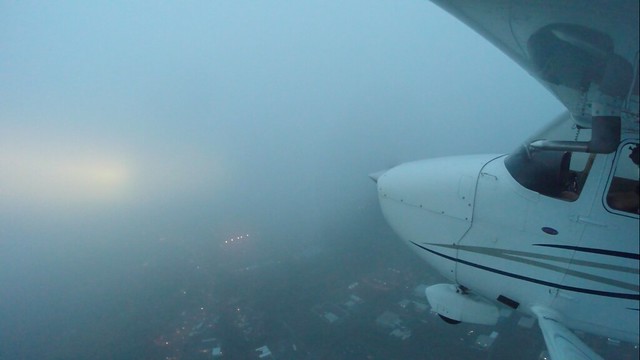
Surprisingly, I get on top of most of the clag at just 3600' with some higher scattered scud higher.
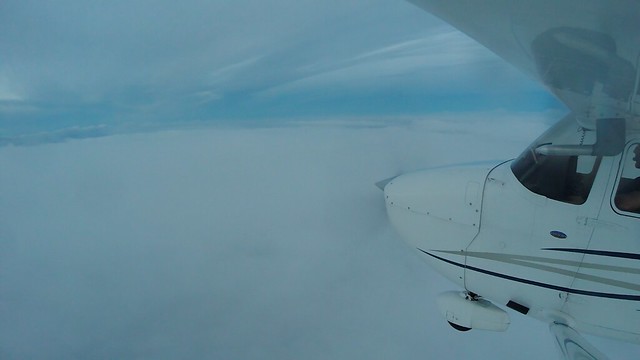
I was really hoping the top of the deck would be crisp (as it usually is with post frontal stratocumulus), but it was fuzzier than I would have liked. That being said, they were distinct enough to have fun surfing.
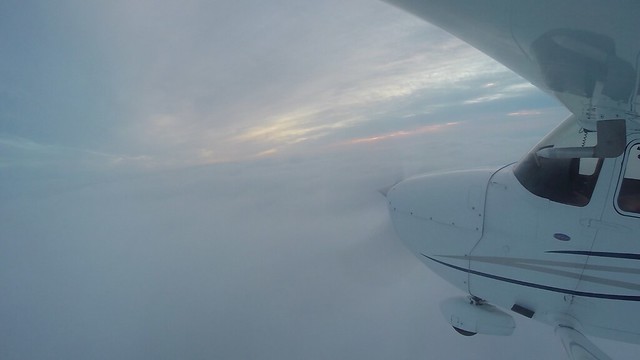
Upon passing through 4000, I asked ATC if I could get a block from 3000 to 4000 to skim the tops. No problem as he immediately approved my request.
I then did a parallel hold entry at DRESS and got some good surfing in as I made my way around the track.
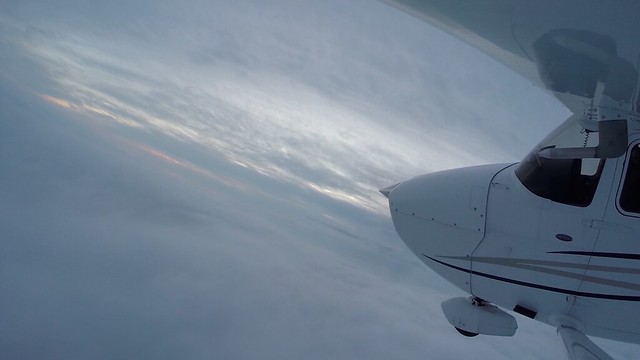
After 2 turns, I ask for the approach and he clears me for the RNAV 2 and also gives me missed app instructions on the go.
I;m back in the abyss at 2900 and break out below the deck at about 1200', more than 800 above the published minimums.
I do a T&G straight into rwy 2 and then check in with approach on the climbout passing though 1200.
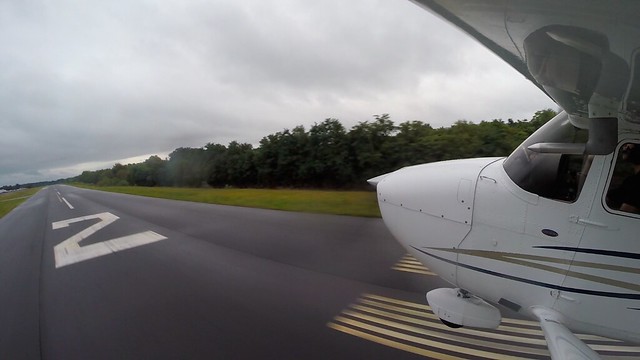
I'm then vectored for a right downwind for the RNAV 2 again and ask for a block from the MVA to 3500, which again he promptly approves.
More cloud surfing???..
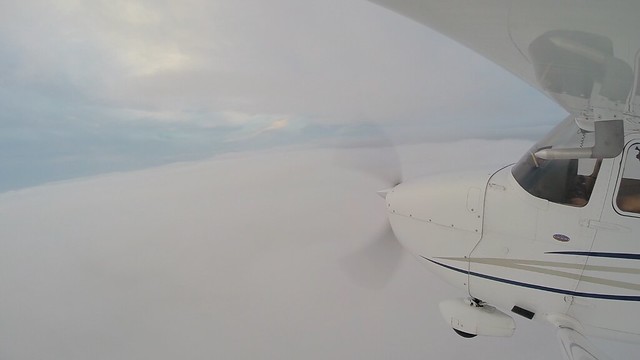
The 2nd approach is similar to the first, except that I break out a bit lower, at 900'.
I decide to have some fun and do a low flyby over the runway at the top of the green (125 KIAS). Living in a populated area, this is my only chance to legally and safely buzz something like this
I quickly trade airspeed for altitude as I near the departure end of Rwy 2 and check in with approach again, tell them that this will be a full stop, and that I'll cancel IFR on the RCO once on the ground.
Just as before I'm given a block altitude to surf as I'm on the right downwind for the RNAV 2.
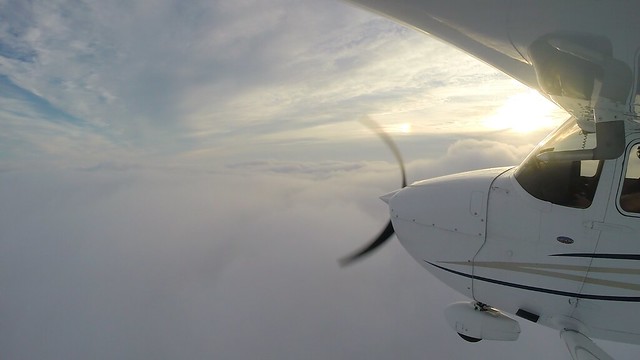
As on the previous app, I break out at 900' and make a straight in for rwy 2. Wanting to again do something different, I decide to practice a short field landing.
Even though the published POH speed for this is 62 KIAS, I find that a speed in the 53-55 kt range is much better since I am well under MTOW flying solo.
This speed works perfectly as I have just 1-2 sec of float once I flare, yet at the same time, still retain ample control authority.
I easily would have had her stopped at the 1000' side markers, but don't bother since the next turnoff is 1500' from the threshold.
Once clearing the rwy, I switch from the CTAF to the RCO and cancel IFR.
Not the most fun IFR I've had, but certainly a utilitarian flight since my IR currency was about to drop off.
https://www.youtube.com/watch?v=VDGOlE-x_9E&feature=youtu.be
Stills: https://www.flickr.com/photos/56841718@N06/albums/72157658528046726
After what has been a very long dry spell when it comes to flyable IMC (at least that's worthwhile), I finally got out there early this morning.
While normally 1500 ft ceilings wouldn't be low enough for me to want to convert 100LL into noise, this time was different because my instrument currency was about to drop off at the end of this month.
The night before, I was closely watching not just the TAF's, but also the RUC skew-t's, and anxiously awaiting each hour when they would be refreshed.
Furthermore, even if the ceilings weren't as low as I wanted, I was at least hoping to skim the tops and get some good footage on my externally mounted Gopro.
Once the RUC skew-t's got within range (18 hrs out), they seemed to indicate that the tops would be in the 4-6K range---just right to do what I want.
I made a phone call to BDL approach, and told the controller my plan for the next day, to make sure that whomever was working could accommodate me a block altitude. At that hour (6:30 AM) he make it should like I could practically ask and get anything in terms of blocks.
I get out of bed at 4 AM and arrive at 5:00 to Robertson Field (4B8) and get all 4 of my Gopro's set up (2 on each strut, 1 on the windscreen, and another facing the panel on the side window).
Being that it was early in the morning, when normally I'd be at my soundest sleep, I allowed extra time to set them up knowing I would not have as much mental bandwidth as i would in the afternoon.
Just as planned, 30 min before sunrise, I reach BDL app on the RCO freq at 4B8 and get my clearance to the IAF for the RNAV 2 into 4B8. I ask if there are any top reports from the BDL departures, so he asks the next guy off, and comes back a few min later to tell me that a Fedex A300 reported the tops at 5000---just about where I'd have expected.
About 10 min later, I ask him if I can have a void time between 6:10 and 6:20 local, and he just tells me he can release me within a minute of when I'm ready.
Sure enough, he clears me immediately for release on the RCO freq and I'm off and on my way on Rwy 20, and cleared to DRESS at 5000, where I requested the published hold.
I enter the bases at 1300' AGL a bit higher than i wanted, but what can you do.

Surprisingly, I get on top of most of the clag at just 3600' with some higher scattered scud higher.

I was really hoping the top of the deck would be crisp (as it usually is with post frontal stratocumulus), but it was fuzzier than I would have liked. That being said, they were distinct enough to have fun surfing.

Upon passing through 4000, I asked ATC if I could get a block from 3000 to 4000 to skim the tops. No problem as he immediately approved my request.
I then did a parallel hold entry at DRESS and got some good surfing in as I made my way around the track.

After 2 turns, I ask for the approach and he clears me for the RNAV 2 and also gives me missed app instructions on the go.
I;m back in the abyss at 2900 and break out below the deck at about 1200', more than 800 above the published minimums.
I do a T&G straight into rwy 2 and then check in with approach on the climbout passing though 1200.

I'm then vectored for a right downwind for the RNAV 2 again and ask for a block from the MVA to 3500, which again he promptly approves.
More cloud surfing???..

The 2nd approach is similar to the first, except that I break out a bit lower, at 900'.
I decide to have some fun and do a low flyby over the runway at the top of the green (125 KIAS). Living in a populated area, this is my only chance to legally and safely buzz something like this
I quickly trade airspeed for altitude as I near the departure end of Rwy 2 and check in with approach again, tell them that this will be a full stop, and that I'll cancel IFR on the RCO once on the ground.
Just as before I'm given a block altitude to surf as I'm on the right downwind for the RNAV 2.

As on the previous app, I break out at 900' and make a straight in for rwy 2. Wanting to again do something different, I decide to practice a short field landing.
Even though the published POH speed for this is 62 KIAS, I find that a speed in the 53-55 kt range is much better since I am well under MTOW flying solo.
This speed works perfectly as I have just 1-2 sec of float once I flare, yet at the same time, still retain ample control authority.
I easily would have had her stopped at the 1000' side markers, but don't bother since the next turnoff is 1500' from the threshold.
Once clearing the rwy, I switch from the CTAF to the RCO and cancel IFR.
Not the most fun IFR I've had, but certainly a utilitarian flight since my IR currency was about to drop off.
